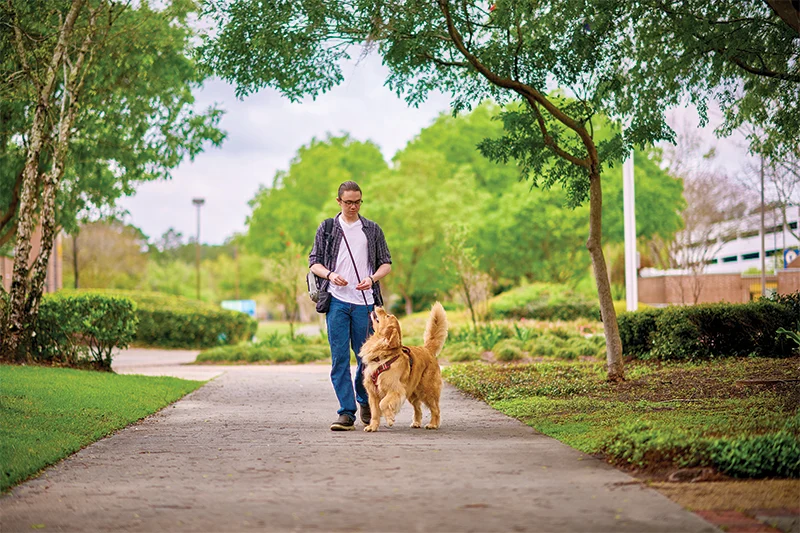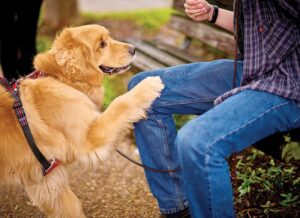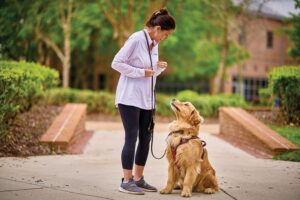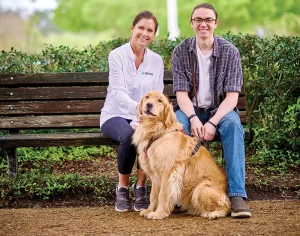
By: HANNAH BURKE – APRIL 30, 2023
EDITOR’S NOTE: We consulted a golden retriever named Grayson in an effort to understand, from his point of view, the role of service dog.
My trainer said I was “the pick of the litter.” I’m not sure what that means, but I remember her taking me aside, away from my brothers and sisters, and telling me, “Grayson, you are going to grow up to have what I consider the hardest job in the world: service dog.”
Well, at least I had the dog part down. And though I was nothing more than a little floofball back then, people told me I was already a stunningly brave boy. I knew how to solve problems and was always up for a challenge.
The challenge of becoming a service dog, I learned, meant going everywhere, yet not reacting to anything save for my person. For a golden retriever like me, that was ludicrous. You’re saying I can’t even chase those pesky squirrels at the park or say hello to that pretty cocker spaniel who frequents the sidewalk cafe?
Just when I was about to raise a stink about it, my trainer told me about my person. Joshua Davey, just 16 at the time, was a Type 1 diabetic (T1D) living in Tallahassee. He would sometimes experience something called nocturnal hypoglycemia, which is a way of saying his blood sugar sometimes drops to dangerously low levels while he’s asleep.

Grayson, a golden retriever, uses a paw to signal Joshua Davey that his blood sugar level is low. Photo by Dave Barfield.
He doesn’t always know when this happens. Joshua has slept through multiple alarms before, and it’s lucky his parents were there to get him the help he needed. He was a young man who would soon be transitioning to college life, when his parents wouldn’t often be around.
That’s why his mother approached my trainer, Barbara White-Willner. Barbara has owned K-9 SOL (Saving One’s Life) in Tallahassee since 2007. She is a certified professional dog trainer who graduated from the National K-9 School for Dog Trainers in Columbus, Ohio, as a master trainer. Over her 40-year career, she has trained thousands of pups to be obedient and provide services and support for humans who have PTSD, mobility and balance issues, and life-threatening diabetes.
I like Barbara. Though I lived with her throughout my training, she always made sure I was bonding with Joshua. She would let me spend weekends with him. Because of that I worked extra hard to become a diabetic alert dog, or DAD.
This training typically takes around two years, but I was so good, I completed mine in 18 months! It wasn’t easy though. It’s a three-part program where you become proficient in obedience, public access and service, but you gotta master the basics first. Becoming properly socialized, house-trained and compliant both on and off leash made me able to now handle stressful, distracting situations in public. And there are plenty of them, let me tell you.
Barbara began acclimating me to the hustle and bustle of the human world early on. She would take me to parks, grocery stores and the mall. I practiced going through security at the airport and rode in all kinds of vehicles. I even learned how to be a good boy while riding in something she called an “elevator.” There’s a lot of shiny buttons in those things and people crowded around you. I wanted to lick ’em or growl at a few of them. That didn’t go over so well, but I learned.

Barbara White-Willner, a certified professional dog trainer and the owner of K-9 SOL in Tallahassee, works with Grayson, an exceptional golden retriever. In 18 months, Grayson completed training that usually requires two years. Photo by Dave Barfield.
Scent training was way more intensive. It was done with some saliva samples Barbara kept in a little tin in the refrigerator, where they lasted for three days, or the freezer, where they lasted three months. Anytime I heard those doors open, I knew we were about to play my favorite game.
Using the tins with the saliva samples, moving them around her body, Barbara taught me to follow a pattern, sniffing from ankle to knee to hip and back down again. Humans sweat in those areas a lot, she said, so it’s easier to pick up their scent in those places and figure out if their blood sugar is low. Once I grasped that, I was able to alert Joshua to a change 20 minutes faster than a continuous glucose monitor could. (Take that, technology!)
It was 1,500 repetitions for each step, if you can imagine. That means 1,500 reps of ankle to knee, another 1,500 from knee to hip and so on. Then Barbara would try to trick me by partially hiding the tin or removing it entirely. We did this in all different places during all times of day and night, so I would be sure to habitually check Joshua.
My reward was my favorite kibble. To manage my weight, Barbara would measure out my food in the morning, and whatever I didn’t eat during my training, I would get to finish for supper.

WORKS FOR KIBBLES – Grayson, a service dog, takes a break with his trainer, Barbara White-Willner, and TCC student Joshua Davey, who Grayson has been groomed to look after. On campus, Grayson enjoys rock-star status. Photo by Dave Barfield.
I had a lot of fun with her, but I was so excited when it came time to live with Joshua. Barbara told him he had a lifetime of support for me, and she was always available to Facetime, answer emails or phone calls if he needed anything. Plus, his mom sends Barbara lots of photos of me and is sure to update her on how I’m doing.
He just enrolled at Tallahassee Community College, and people called me a “rock star” when I went to school with him.
I may have the hardest job in the world, but spending every day with my best friend, going on adventures and saving a life along the way? Not a bad gig, if you ask me.
Story Credit:
